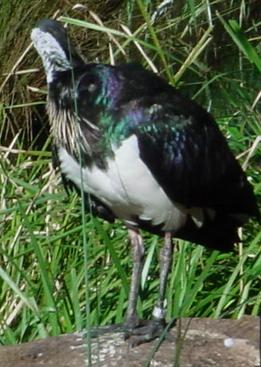|
| 질의: White ibis | 결과: 26번째/152 | |
Ibis (Family: Threskiornithidae) - Wiki
| 제목: | Ibis (Family: Threskiornithidae) - Wiki
| |

| 해상도: 261x367
파일크기: 23980 Bytes
등록시간: 2007:10:24 14:09:03
|
Ibis
From Wikipedia, the free encyclopedia
[Photo] Straw-necked Ibis, Threskiornis spinicollis. Phot by http://en.wikipedia.org/wiki/User:Tannin and released into the public domain.
Ibises (pronounced "EYE-bis-es") are a group kof long-legged wading birds in the family Threskiornithidae. They all have long down curved bills, and usually feed as a group, probing mud for food items, usually crustaceans. Most species nest in trees, often with spoonbills or herons.
The word ibis comes from Greek, originally borrowed from Ancient Egyptian h??b.
Folklore
The Sacred Ibis was also an object of religious veneration in ancient Egypt, particularly associated with the god, Thoth. At the town of Hermopolis, ibises were reared specifically for sacrificial purposes and in the Serapeum at Saqqara, archaeologists found the mummies of one and a half million ibises and hundreds of thousand of falcons. (cf. "The Way to Eternity: Egyptian Myth", Time-Life Books, Duncan Baird Publishers, 1997, pages 66-67)
Species in taxonomic order
Genus Threskiornis
Sacred Ibis, Threskiornis aethiopicus
Madagascar Sacred Ibis, Threskiornis bernieri
R??union Sacred Ibis, Threskiornis solitarius extinct
Black-headed Ibis, Threskiornis melanocephalus
Australian White Ibis, Threskiornis molucca
Straw-necked Ibis, Threskiornis spinicollis
Genus Pseudibis
Indian Black Ibis, Pseudibis papillosa
White-shouldered Ibis, Pseudibis davisoni
Genus Thaumatibis
Giant Ibis, Thaumatibis gigantea
Genus Geronticus
Northern Bald Ibis, Geronticus eremita
Southern Bald Ibis, Geronticus calvus
Genus Nipponia
Japanese Crested Ibis, Nipponia nippon
Genus Bostrychia
Olive Ibis, Bostrychia olivacea
Dwarf Olive Ibis, Bostrychia bocagei
Spot-breasted Ibis, Bostrychia rara
Hadada Ibis, Bostrychia hagedash
Wattled Ibis, Bostrychia carunculata
Genus Theristicus
Plumbeous Ibis, Theristicus caerulescens
Buff-necked Ibis, Theristicus caudatus
Andean Ibis, Theristicus branickii
Black-faced Ibis, Theristicus melanopis
Genus Cercibis
Sharp-tailed Ibis, Cercibis oxycerca
Genus Mesembrinibis
Green Ibis, Mesembrinibis cayennensis
Genus Phimosus
Whispering Ibis, Phimosus infuscatus
Genus Eudocimus
American White Ibis, Eudocimus albus
Scarlet Ibis, Eudocimus ruber
Genus Plegadis
Glossy Ibis, Plegadis falcinellus
White-faced Ibis, Plegadis chihi
Puna Ibis, Plegadis ridgwayi
Genus Lophotibis
Madagascar Crested Ibis, Lophotibis cristata
http://en.wikipedia.org/wiki/Ibis
| The text in this page is based on the copyrighted Wikipedia article shown in above URL. It is used under the GNU Free Documentation License. You may redistribute it, verbatim or modified, providing that you comply with the terms of the GFDL. |
|
댓글 |
|---|
| | Samuel |
|
| 2gSy3Y Hello! I'm Samuel Smith, i'm from Switqerland i and find your site really brilliant! |
| | 손님 |
|
Straw-necked Ibis
Threskiornis spinicollis
The Straw-necked Ibis is a large waterbird with a naked black head, long downcurved black bill and yellow throat plumes. It has a glossy blue-black back, with metallic purple, green and bronze sheen, a white nape and sides of neck and white underparts. Its preference for grassland insects such as grasshoppers and locusts have earnt it the name of Farmer's Friend. |
^o^
동물그림창고 똑똑전화 누리집
^o^
|
|
|